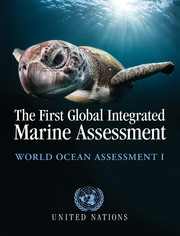Book contents
- Frontmatter
- Dedication
- Epigraph
- Contents
- Foreword and Preface
- Preface
- Summary of the first global integrated marine assessment
- The context of the assessment
- Assessment of Major Ecosystem Services from the Marine Environment (Other than Provisioning Services)
- Assessment of the Cross-cutting Issues: Food Security and Food Safety
- Assessment of Other Human Activities and the Marine Environment
- Assessment of Marine Biological Diversity and Habitats
- Section A Overview of Marine Biological Diversity
- Chapter 36 Overview of Marine Biological Diversity
- Section B Marine Ecosystems, Species and Habitats Scientifically Identified as Threatened, Declining or Otherwise in need of Special Attention or Protection
- I Marine Species
- II Marine Ecosystems and Habitats
- Chapter 42 Cold-Water Corals
- Chapter 43 Tropical and Sub-Tropical Coral Reefs
- Chapter 44 Estuaries and Deltas
- Chapter 45 Hydrothermal Vents and Cold Seeps
- Chapter 46 High-Latitude Ice and the Biodiversity Dependent on it
- Chapter 47 Kelp Forests and Seagrass Meadows
- Chapter 48 Mangroves
- Chapter 49 Salt Marshes
- Chapter 50 Sargasso Sea
- Chapter 51 Biological Communities on Seamounts and Other Submarine Features Potentially Threatened by Disturbance
- Section C Environmental, economic and/or social aspects of the conservation of marine species and habitats and capacity-building needs
- Overall Assessment
- Annexes
- References
Chapter 50 - Sargasso Sea
from II - Marine Ecosystems and Habitats
Published online by Cambridge University Press: 18 May 2017
- Frontmatter
- Dedication
- Epigraph
- Contents
- Foreword and Preface
- Preface
- Summary of the first global integrated marine assessment
- The context of the assessment
- Assessment of Major Ecosystem Services from the Marine Environment (Other than Provisioning Services)
- Assessment of the Cross-cutting Issues: Food Security and Food Safety
- Assessment of Other Human Activities and the Marine Environment
- Assessment of Marine Biological Diversity and Habitats
- Section A Overview of Marine Biological Diversity
- Chapter 36 Overview of Marine Biological Diversity
- Section B Marine Ecosystems, Species and Habitats Scientifically Identified as Threatened, Declining or Otherwise in need of Special Attention or Protection
- I Marine Species
- II Marine Ecosystems and Habitats
- Chapter 42 Cold-Water Corals
- Chapter 43 Tropical and Sub-Tropical Coral Reefs
- Chapter 44 Estuaries and Deltas
- Chapter 45 Hydrothermal Vents and Cold Seeps
- Chapter 46 High-Latitude Ice and the Biodiversity Dependent on it
- Chapter 47 Kelp Forests and Seagrass Meadows
- Chapter 48 Mangroves
- Chapter 49 Salt Marshes
- Chapter 50 Sargasso Sea
- Chapter 51 Biological Communities on Seamounts and Other Submarine Features Potentially Threatened by Disturbance
- Section C Environmental, economic and/or social aspects of the conservation of marine species and habitats and capacity-building needs
- Overall Assessment
- Annexes
- References
Summary
Inventory
The Sargasso Sea is a fundamentally important area of the open ocean within the North Atlantic Sub-Tropical Gyre, bounded on all sides by clockwise rotating currents (Laffoley et al., 2011).
Named after its iconic Sargassum seaweed, the Sargasso Sea's importance derives from the interdependent mix of its physical oceanography, its ecosystems, and its role in global-scale ocean and earth system processes. It is a place of legend, with a distinct pelagic ecosystem based upon two species of floating Sargassum, the world's only macroalgae that spend their whole life-cycle in the water column (holopelagic), which hosts a rich and diverse community, including ten endemic species. Sargassum mats are home to >145 invertebrate species and >127 species of fish; the mats act as important spawning, nursery and feeding areas for fish, turtles and seabirds. In deeper water, the Sargasso Sea is the only known spawning area for both the European and American Eels (Anguilla anguilla, A. rostrata). Porbeagle Sharks (Lamna nasus) migrate from Canada to the Sargasso Sea, where they are suspected of pupping in deep water; several other shark species undertake similar migrations and may be using the area as nursery areas. Thirty species of whales occur in the Sargasso Sea and Humpback Whales (Megaptera novaeangliae) make regular migrations through the area en route from the Caribbean to the northern North Atlantic. Many other species, including several tuna spp., turtles, rays and swordfish, migrate through the Sargasso Sea: it is truly an ecological crossroads in the Atlantic Ocean, linking its own distinct ecosystem with Africa, the Americas, the Caribbean and Europe. Seamounts and volcanic banks rise up from the sea floor and host diverse and fragile communities of invertebrates and fish, including endemic species and others that are currently undescribed. Many of the species that occur in the Sargasso Sea are endangered or threatened and are listed on the IUCN Red List, and/or in the appendices of the Convention on International Trade in Endangered Species of Wild Fauna and Flora1 (CITES) or in the annexes of the 1990 Caribbean Protocol Concerning Specially Protected Areas and Wildlife2 to the Convention for the Protection and Development of the Marine Environment in the Wider Caribbean Region3 (SPAW) (see Laffoley et al., 2011).
- Type
- Chapter
- Information
- The First Global Integrated Marine AssessmentWorld Ocean Assessment I, pp. 893 - 898Publisher: Cambridge University PressPrint publication year: 2017

